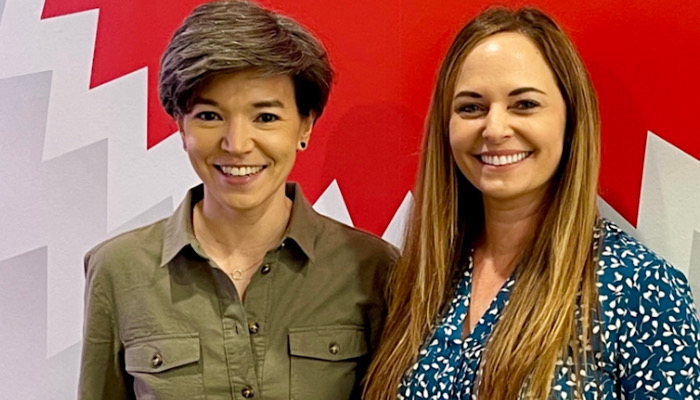Mattel’s Sarah Franco and Audrey Watanabe talk sell sheets, sizzles and pitches

Today, we’re talking about participating in the Mojo Pitch online. In terms of what inventors might want to consider showing you, for what kind of products are you looking?
Audrey: We’re very excited to be participating virtually in the Mojo Pitch event again and can’t wait to see all the innovative toys and games that the inventors have developed! This year, the Mattel product categories that will be participating are Action Figures, Vehicles and Games.
Perfect. And in terms of more general toys and games?
Audrey: As an overarching statement, we’re looking for toys and games that amplify our existing Mattel brands in new and innovative ways. We have a huge portfolio of powerhouse brands, and we’re always seeking to leverage our IP to its fullest potential with fresh perspectives – this is why we love working with inventors!
More specifically, we’re interested in seeing cool toy mechanisms and/or clever game play mechanics. Diving a bit deeper, we want concepts that have great value. Considering price points, manufacturing feasibility, and component/piece count are all important – but bottom line, the toy or game needs to be FUN – and STAY FUN! Replayability is critical. Consumers are much more conscious of their spending nowadays and want to make purchases that have longevity and strong replay value.
Excellent answer. Thank you, Audrey. Sarah, into what thinking traps do people fall when pitching to Mattel? Common mistakes you think inventors could avoid making?
Sarah: Every inventor partner has their own style when it comes to pitching ideas to us. Some are more polished, and some require more discussion. With that said, I’d say the biggest mistake is not tailoring your presentation to your audience. It’s key to familiarise yourself with the Mattel brands. Treat your presentation like an interview. You’d never interview with a company without understanding what they do and/or sell.

The second mistake is not doing your research… You need to walk the toy aisles. Do you see any trends? What’s selling? Is your concept new? Do a quick Google search and see if similar products come up. The last one is less common, but it’s important to emphasise… Show enthusiasm and energy in your pitch. If you aren’t excited about your product, then no one else will be. You set the tone for the meeting – so keep it positive.
And in terms of a pitch structure, what do you prefer inventors to do? Is there any particular order in which you like them to unpack information?
Audrey: Toys and games pitches can be very different, just by nature of the product form and what information needs to be highlighted to understand the concept. I can speak specifically for game pitches. It’s essential to cover the basic gameplay mechanics: What’s the objective of the game? What actions do you take on your turn? How do you win?
In saying this, conveying the moment of FUN in the game is just as important as explaining the gameplay – perhaps even more so. What’s that unique, unexpected twist in the game play that makes it fun? The buildup of excitement and anticipation during play, that “wow!” payoff moment, the unexpected – that’s the FUN!
Sarah, same question to you…
Sarah: I suggest leading with your best and new concepts first, those you’re most excited to share. In regard to ‘unpacking’ your idea specifically for toy pitches, it’s helpful to begin with your research, references, inspiration, or even a context page – ‘the reason for being’.
Could you give us an example of that? What kind of thing, for instance?
Sure! Let’s say you’re pitching a Jurassic World dinosaur concept, and your idea has a very specific and intentional design feature relating to a moment in the film… Then show us the moment you’re referencing during your pitch. It helps us better understand how you’ve translated the movie’s storyline into a compelling toy. Another recommendation is to group together concepts with similar ideas or within the same brand category. That makes it easier to compare items… This way we can select the most fitting and strongest candidates for our line plan needs.

I’m also curious to ask… How complete does a concept need to be in order for you to feel it’s worth consideration?
Sarah: For toy ideas, it really depends on how unique and/or complicated your idea is – in terms of understanding how it’s intended to work. For more complex mechanisms – or concepts with multiple features – it’s suggested to show a working prototype. It doesn’t have to be fully polished, but enough to show proof of concept.
Doesn’t need to look finished – does need to prove the concept…
Sarah: Exactly. Prototypes really do help bring an idea to life and showcase confidence in how it would work. It also shows that you considered how it might be engineered/ manufactured, which is great to start that collaborative thinking early on.
Perfect! And for games?
Audrey: It’s similar for games. You should definitely conduct playtesting – a lot of playtesting – and share insights from that. Test with different player audiences and skill sets, be able to speak to why you made the design decisions you did to make your game idea as compelling as possible. The game doesn’t have to look fancy; I’ve seen awesome game concepts mocked up with hacked together parts and index cards – which is totally fine, and I love to see! Good game mechanics and a thoroughly tested, well-thought-through play experience are the priority over an aesthetically beautiful prototype.
Looking at how inventors communicate, what’s your view on sell sheets? Or PowerPoint presentations shared online?
Audrey: As our standard policy, we don’t accept any proposals or submission materials online outside our submission portal or vetted pitching events. This is for the legal protection of both Mattel and the inventor’s IP. During an online pitch, though, sell sheets and PowerPoints are – in my opinion – great for providing supplementary details…

They can help show context for your idea such as trends, market research and/or the vision of how your idea could be applied across multiple brands. But what we’re primarily interested in, as far as pitch materials, is a well-crafted sizzle video. This is also a required asset when uploading to our portal system. So: during virtual pitch meetings, I say utilise any tools necessary to make your presentation as polished, compelling, and easy to understand as possible.
Perfect, that’s crystal clear – thank you. Let’s stay on the subject of sizzle videos… What length should they be? Is there any particular structure you like to see?
Sarah: We see thousands of submissions a year so there are a lot of ideas to share with our teams. Definitely keep your video under two minutes; with the sweet spot being around 45 secs to one minute. Your sizzle should include the name of your product, your name/company, and any collaborators. Make sure you speak clearly in the video and avoid background noise…
Do you know what? Hardly anybody says that, but yes! I often strain to hear what people are saying on a sizzle…
Sarah: Yes! And that can be very unhelpful. Also, be sure to showcase your invention and highlight the main play features. Not every detail has to fit into one video. To Audrey’s earlier point, you can add additional drawings, presentations, and videos to support your submission. One format that works well for some is a sizzle video that acts like a commercial to sell the toy and a second video that explains how it works and expands on the play pattern.
Fantastic! Yes. A short video that shows what an advert would show, and another video that peeks behind the curtain a bit. What other advice might you give inventors here?
Sarah: After submitting an idea, be patient – ha! It’s an incredible opportunity to license a toy or game, but it can be a lengthy process. It takes time to get an idea in front of the right decision-makers and more time to meet the necessary development milestones. Check-ins are okay but be reasonable with timing and please don’t be pushy…
Because you and Audrey aren’t just seeing the idea and making a decision… You’re more or less using the sizzles and supporting material to pitch it to other people inside Mattel?
Sarah: Exactly. And in toy and game development, there’s a lot of departments involved, each needing the appropriate amount of time to do their part in the review process. But that patience will pay off when you see your toy and/or game idea on retail shelves – an exciting and long-anticipated moment of celebration!
Audrey: Finally, remember that we’re here to help! We recognise that Mattel is a big company with a lot of moving parts. Our Inventor Relations department is here to navigate the process for you. We’re advocating for both our internal brand teams and the inventors – championing for your ideas throughout the entire development process. Our IR team has a wealth of knowledge about Mattel, our brands, product categories and development process – we’re available, and welcome the opportunity to offer guidance and support to inventors. Build relationships with your IR reps – we’re here for YOU! Ultimately, we want mutual success in creating innovative, FUN toys and games!
Great stuff. Audrey, Sarah: thank you so much for sharing your thoughts.
–
To stay in the loop with the latest news, interviews and features from the world of toy and game design, sign up to our weekly newsletter here






















